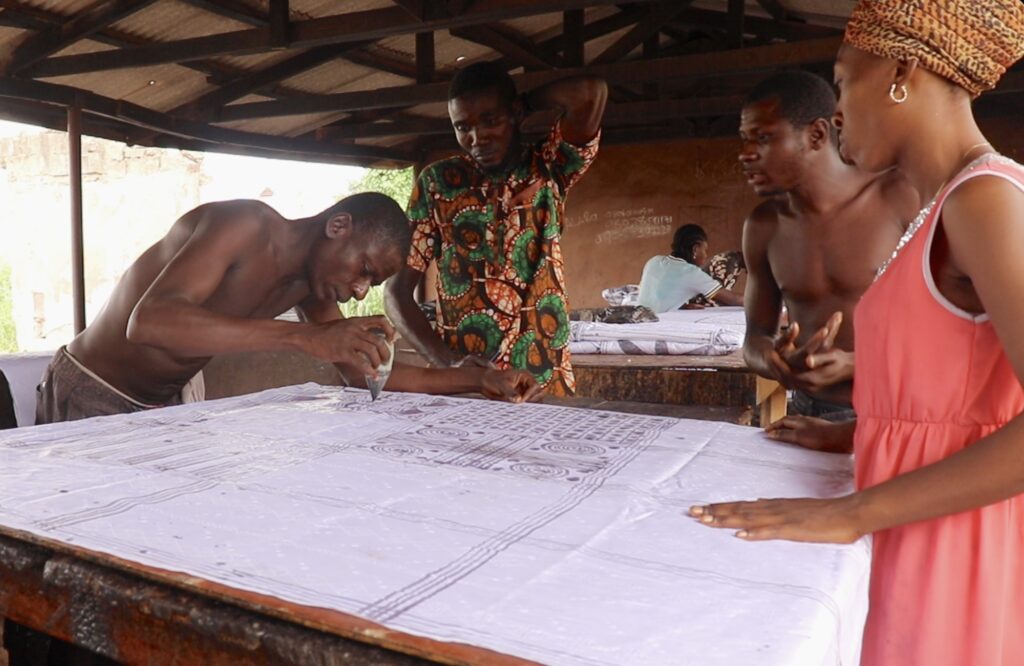Featured Articles
In Nigeria, Brooklyn and Other Points Abroad, Ancient Art of Tie-Dye Thrives
By Oluwatobi Oyinloye
Adesina Adeseye dips a sponge into wax that was boiling in a tin pot sitting directly on top of a cylinder of propane gas. Quickly, he moves the sponge across plain white fabric, making whirls, swirls, straight lines, dots and all sorts of asymmetrical shapes.
When the wax dries, he dunks the fabric into hot water that is royal blue, a color created by mixing dye powder, citric acid and caustic soda into the water. The dye takes as the wax melts away.
“Our work is very important. It ensures our ancestors didn’t die in vain,” says Adeseye, of what, in Nigeria’s Yoruba language, is the art of making adire textiles and in the English-speaking world is called tie-dyeing.
After 20 years of designing and selling adire, Adeseye says he’s gotten used to the heat and learned how not not burn his flesh when he’s at work. Adeseye learned his art from the woman they call only by one name, Iya-oloja. She runs the Adire Kampala International Market in Asero Abeokuta, a city of 500,000 people that is two hours’ drive from Lagos, Nigeria’s business capitol. Visitors who want to photograph or ask questions of the 100 adire-makers in that market must get her permission. And they must pay. She’ll accept 5,000 nira, the Nigerian currency, which equals about $12.15.
They’re that protective of what they do, partly because, over the years, visitors from around the world have come here, photographed the work, learnt the artisans’ techniques, reproduced the work and sold it at premium prices. The proof, the textile- makers say, are the online stories selling tie-dye with designs that area almost the exact same as theirs.
“They’re eating the labor and creativity of us, which doesn’t speak well for this traditional practice,” says Ilesomi Titus, who’s been making adire for almost 10 years.
Artisan Medinat Adebiyi, who has been tie-dyeing for 15 years, says, of what the imitators produce, “It can never look like ours.” There are certain traditions in textile-making that the real adire workers follow. Tie-dye fabrics that are mass-produced by modern machines also lack the unique look and feel as tie-dye done by hand, Adebiyi adds.
Tie-dye has gained popularity over the years, reaching its peak in 2020, according to Google Trends. The BBC listed tie-dyed attire on a list of 10 fashion stylings to watch in 2021. In November 2020, Gov. Dapo Abiodun, announced that public schools his state, Ogun, Nigeria, would have adire built into the fabric of students’ uniforms.
In Nigeria, such urban designers as Adire Republic and Aries Couture have been making adire a centerpiece of their clothing.
In New York, designer, Brooklyn fashion designer, Busayo Olupona, who grew up in Nigeria and sells her clothes online and through such stores as Saks Fifth Avenue, tells The Spectrum, via email, that she’s been working with adire for the last 10 years. “It’s the medium through which I felt I could best express my passion for Yoruba culture … Those textiles still tell a powerful story … And, frankly, [they are] so fun, vibrant and gorgeous.”
Her goal, adds the owner of Busayo NYC, is “to be a global, yet decidedly Nigerian brand that leverages the immense talent of Nigerian people to create an ecosystem that creates jobs and builds opportunities.”
who owns Brooklyn-based BusayoNYC,


